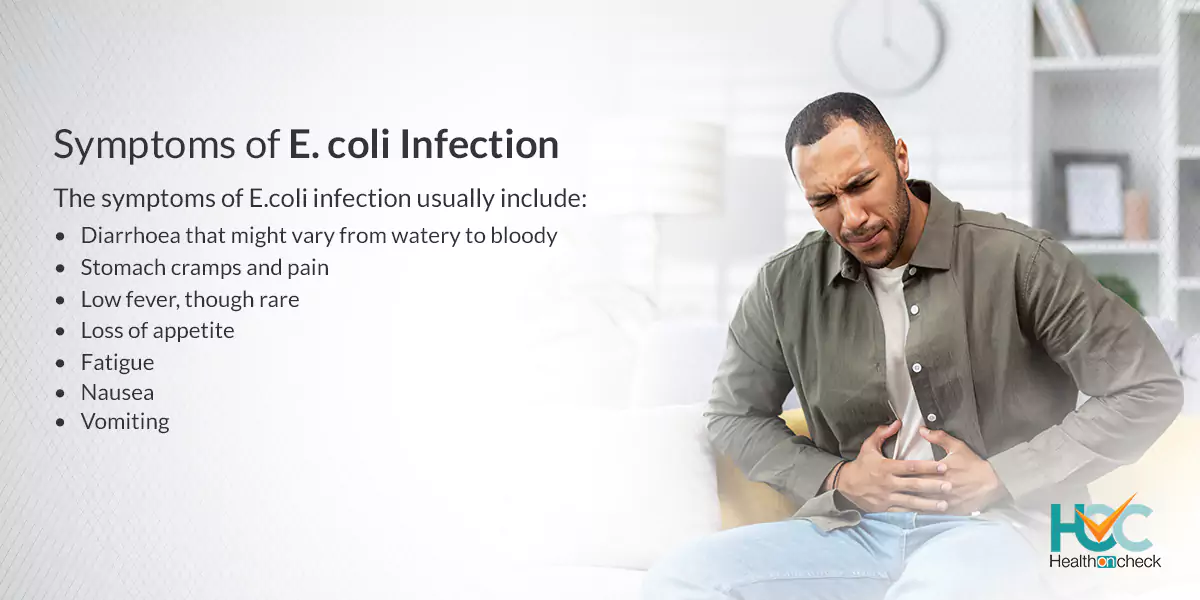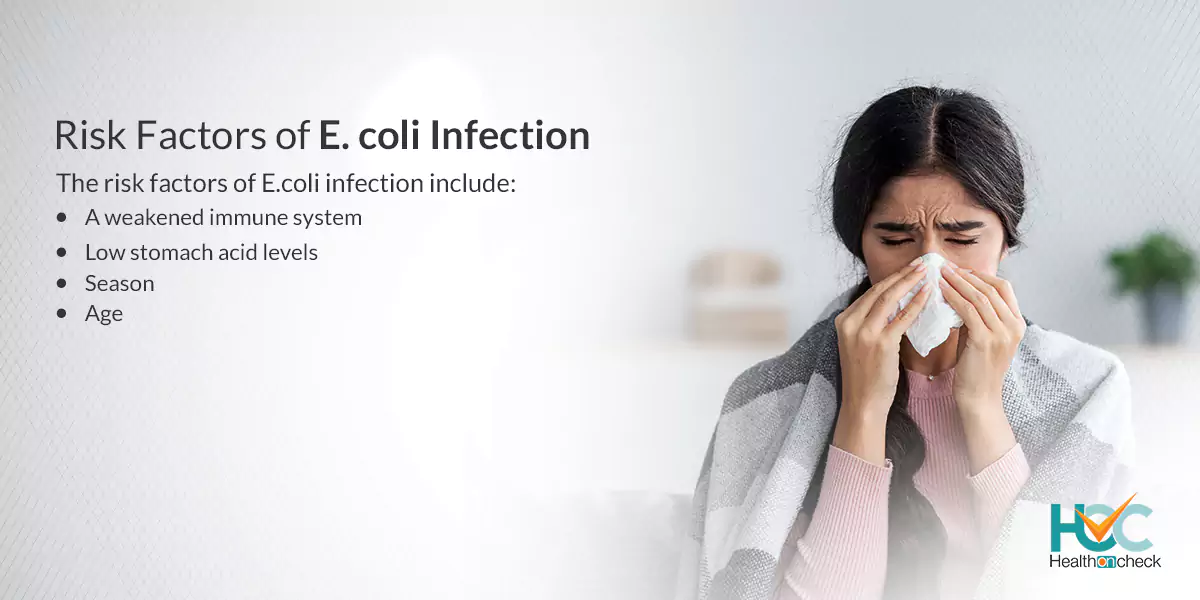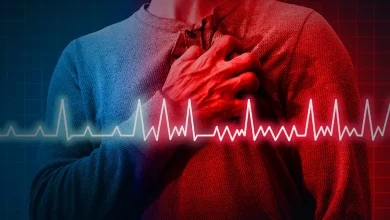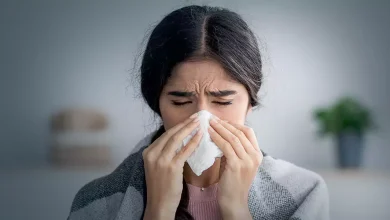What is E. coli Infection?
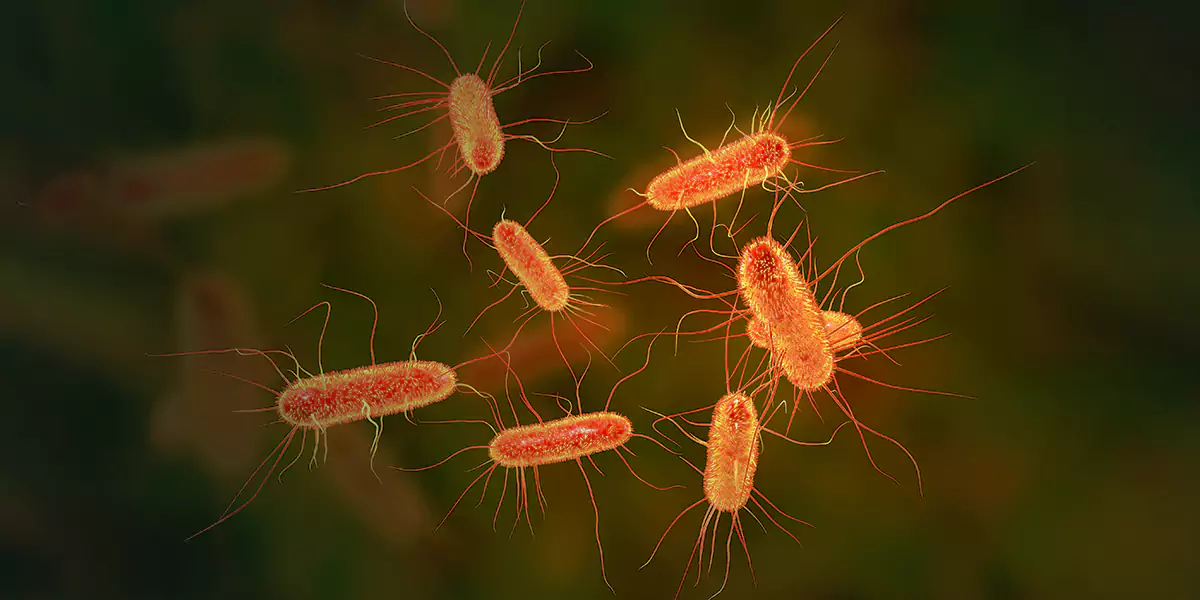
E. coli is a bacterium that usually resides in your intestines. Most strains are normally harmless but certain types can lead to an intestinal infection. It can cause likely severe life-threatening complications. Some strains such as E. coli O157:H7 cause health complications such as diarrhoea/bloody diarrhoea, vomiting, cramps, and stomach pains. If not managed properly then one strain can result in kidney failure also. The most common way to get an E. coli infection is by eating contaminated food. People mostly recover within a week without medications but proper treatment is needed in some cases.
What are the Types of E. coli Infection?
There are various subtypes of E. coli but most of them are harmless to humans. However, six subtypes can cause intestinal illness. These include:
– Enterotoxigenic Escherichia coli (ETEC)
It usually develops in communities where there is a lack of adequate water and food sanitation measures. In the areas with limited sanitation resources, it’s the subtype that causes traveller’s diarrhoea and dehydrating diarrhoea in infants.
– Enterohemorrhagic Escherichia coli (EHEC)
It includes the most common type of E.coli that leads to disease in humans. Previous outbreaks of EHEC occurred because of people eating contaminated fruit and vegetable produce and undercooked beef. Usually, this subtype is found most in ground beef.
– Enteropathogenic Escherichia coli (EPEC)
This type causes watery diarrhoea and it can also transmit from person to person. People usually get EPEC by eating unsanitary vegetable produce.
– Enteroaggregative Escherichia coli (EAEC)
Researchers have recently found that EAEC is an increasingly common reason for traveller’s diarrhoea in regions that have abundant sanitation resources and also in regions that do not have enough sanitation resources.
– Enteroinvasive Escherichia coli (EIEC)
This type is less common than the others and is closely connected to Shigella, a different bacteria that causes gastrointestinal distress.
– Diffusely adherent Escherichia coli (DAEC)
It uniformly covers the surface of cells, which makes it different from other types. It can cause diarrhoea in humans, especially in young children.
What are the Symptoms of E. coli Infection?
The symptoms of E.coli infection usually include:
– Stomach cramps and pain.
– Diarrhoea that might vary from watery to bloody.
– Fatigue.
– Loss of appetite
– Nausea.
– Vomiting.
– Low fever, though rare.
What are the Causes of E. coli Infection?
One can acquire an E. coli infection by ingesting (taking in by mouth) some specific strains of E. coli bacteria where the bacteria flows in your digestive tract and releases a destructive toxin, known as Shiga toxin, which harms the lining of your small intestine. The symptoms are caused by growing symptoms.
You come into contact and ingest E. coli by consuming contaminated food, contaminated water, or by touching your mouth with your hands contaminated with E. coli bacteria.
You can get E.coli infection through:
Contaminated foods
– Meats
During the slaughtering procedure, the mean can become contaminated when E. coli in animal intestines spreads into pieces of meat especially when meat from more than one animal is kept together. If you eat undercooked meat, you can acquire E. coli infection.
– Unpasteurized (raw) milk
If there is E. coli on a cow’s udder or the milking equipment then it can spread into the milk. Drinking contaminated raw milk can cause an E. coli infection especially if it is not heated enough to kill the bacteria.
– Unpasteurized apple cider and other unpasteurized juices can also contain E.- coli and cause E. coli infection.
– Soft cheeses made from raw milk might contain E.coli.
– Fruits and vegetables
If there are crops such as fruits and vegetables growing near animal farms then it can become contaminated when E. coli-containing animal poop mixes with rainwater and gets into the crops. If you don’t wash the crops thoroughly, E. coli can enter your body when you eat these foods.
Contaminated water
E. coli in poop from both humans and animals can enter all forms of water sources such as lakes, ponds, rivers, streams, wells, swimming pools, and even in local city water supplies if they are disinfected. When you consume contaminated water, you could get an E. coli infection.
Contaminated hands
E. coli can enter your body if they are present in your hand and you eat food without properly washing your hands. You can get E.coli on your hands by touching poop after changing your baby’s diapers, after passing stool and not washing your hands properly, or from poop on the hands of other people infected with E. coli.
What are the Risk Factors of E. coli Infection?
The risk factors of E.coli infection include:
– Age
Older adults are more prone to experience serious complications because of E. coli infection.
– A weakened immune system
People with weakened immune systems have an increased risk of getting E. coli infections.
– Season
E. coli infection tends to spread more during the summer months, for unknown reasons.
– Low stomach acid levels
Medications that help to reduce your stomach acid levels can augment your risk of getting an E. coli infection.
What are the Complications of E. coli Infection?
People mostly adults recover from E. coli illness within five to seven days but people from certain age groups — especially young children and older adults might develop a life-threatening form of kidney failure called hemolytic uremic syndrome if they don’t get proper treatment. This condition can permanently damage the kidneys. The infection can also enter the bloodstream, though it’s rare but if it does then it can cause a potentially deadly infection called sepsis.
Other complications of E.coli infection might include:
– Urinary tract infection
– Pelvic and abdominal infection
– Pneumonia
– Bacteremia, where the bacteria enter the bloodstream
– Meningitis, where the bacteria pass the blood-brain barrier
How Is E. coli Infection Diagnosed?
E. coli infection is diagnosed by checking the presence of E. coli bacteria in your stool by sending a sample of your stool to a laboratory for examination. The bacteria might be cultured to confirm the diagnosis and identify certain toxins, like those produced by E. coli O157:H7.
What are the Treatment Options Available for E. coli Infection?
At present, there are no treatments available to cure the infection, relieve symptoms, or prevent complications for the illness caused by E. coli but fortunately, most E. coli infections go away on their own. You can manage the symptoms of E. coli infection by drinking plenty of fluids to replace the loss caused because of diarrhoea and/or vomiting along with getting as much rest as possible.
Usually, antibiotics are not given for STEC O157 infection because they can worsen your illness worse and increase the risk for hemolytic uremic syndrome (HUS). Also, you should not take medicines to prevent diarrhoea because it could make the E. coli bacteria stay in your body and increase your chance of getting HUS.
Usually, people start feeling better after five to seven days from the time they first develop symptoms.
Living with E.coli Infection?
You should know that most strains of E. coli are harmless. They exist in your intestinal tract naturally and help in digesting your food. But if you eat food or drink water that is contaminated with illness-causing E. coli, then you may get ill and cause a brief episode of diarrhoea. Other strains of E. coli, the Shiga toxin-producing E. coli (STEC), can lead to bloody diarrhoea, vomiting, stomach pain, and cramps. People usually recover from E. coli infection within about a week without taking any treatment.
Whom to Consult?
If you have had diarrhoea, especially bloody diarrhoea for more than three days, and find it difficult to keep fluids down along with having continuous bouts of vomiting and a fever, then you should contact your doctor. These symptoms might imply you are developing serious complications that could result in kidney failure. Otherwise, E. coli infection goes away on its own in a few days.

